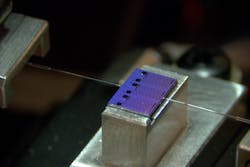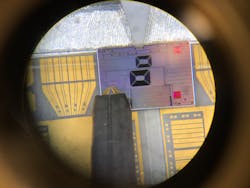At 31 years old, Kevin McComber—with an engineering PhD from MIT and a passion for semiconductor manufacturing—found himself working in an insurance claims group, wondering if he had just made a colossal career blunder. Little did he know then that a detour into a seemingly unrelated industry would play a vital role in his future as an entrepreneur in an industry he felt drawn to since elementary school.
As a second grader, McComber realized he loved math and, with the encouragement of one of his teachers, determined engineering was the career for him. By seventh grade, he had set his sights on attending the Massachusetts Institute of Technology (MIT) near Boston.
Fast forward six years, and he realized that dream. As an undergrad at MIT, McComber studied materials science and engineering and found specialization in working in the cleanroom. That education and experience carried through to his graduate work where he began exploring integrated photonics with an emphasis on silicon photonics, earning a PhD in that specialization.
Building a career foundation
While he had a passion for fabrication, McComber was uncertain how that would unfold in a career trajectory. But when he came upon a position at Intel in Arizona, as a senior process engineer in high-volume manufacturing, he found a perfect fit. Supporting the development of some of the most significant technologies of the time (2011-2014), McComber loved his work being at the leading edge of a critical time in Intel’s microelectronic processing history. He also learned process skills on the job, identifying efficiencies and how to streamline work through information sharing and standardization. In this role, he discovered that manufacturing was as much about the people performing the functions as it was about the technology itself.
McComber admits he would have stayed in that job for an extended duration. However, due to family considerations, he and his wife moved back to Boston.
Following an unexpected path
It was then that McComber first dipped his toes into entrepreneurship by starting a technical consulting company. But when the company’s main client’s government contract ended, McComber found himself looking for a new challenge—and landed in insurance, working in the special investigations unit of the claims group at industry giant Liberty Mutual.
It turned out the position at Liberty Mutual was a process engineering role, one that he was well suited to fulfill. McComber compared it to his time at Intel overseeing the processing of thousands of wafers a day, where Liberty Mutual processes thousands of claims a day. It was about identifying how to do that more efficiently and effectively.
Still, for someone with McComber’s passion and background, the move to insurance was an unlikely path. “I felt it may be good for me to see a world outside the technology sector, but I heard from many people that once I left tech, it would be very hard to get back into the industry,” he says. “It was an extremely difficult decision for me, and there were many times in that transition when I questioned my own judgment and career direction.”
His insurance role led him to a deeper exploration of business management. McComber spent time first in the claims group and then moved to a management consulting position in Liberty Mutual’s corporate strategy and research group, where he learned how to present operational details to management and solicit client feedback. To this day, he attributes this experience as pivotal for the formation of Spark Photonics.
According to McComber, a successful business needs to embrace communication. His management experience and time at Liberty Mutual helped to reinforce his presentation and delivery skillsets. Specifically, McComber points to learning how to structure communications in a digestible way. He emphasizes that entrepreneurs and business leaders must distill information into main points that speak to the audience’s interest. Ultimately, those strengths would serve him well in the launch of Spark Photonics.
Igniting the Spark
In 2018, McComber’s former PhD advisor, Professor Lionel Kimerling at MIT, proposed that McComber join his team at MIT in support of the American Institute for Manufacturing Integrated Photonics (AIM Photonics) as a manager of education and workforce development efforts. The invitation was the kind of break McComber had hoped for to bring him back into the tech industry.
At MIT, one of his primary roles was to develop design services and integrated photonics support for companies. McComber quickly noted that it wouldn’t be feasible through MIT; a commercial entity was required to field the needs of the community in photonic integrated circuits (PICs). That knowledge, combined with his acquired skills in management and business, led him to take the leap and launch Spark Photonics in 2019.
Working with cofounder Al Kapoor, the company sought to address the burgeoning demand for PICs in a scalable way, a risk that took them into uncharted territory. But McComber saw it as an opportunity to make a tangible impact and launch a company that would delight its customers, partners, and employees.
Solving the hiring gap
As the company began to grow, it very quickly encountered the challenge of hiring. McComber witnessed a dearth of available talent in integrated photonics and felt a need to address that in some way. Thinking about his childhood experience of finding his passion in math and having a teacher guide him toward engineering, he saw an opportunity to do the same.
The Spark Photonics team took it upon themselves to address the talent gap by engaging younger generations in elementary, middle, and high school education. From that concept, a new division of the organization—the Spark Photonics Foundation—was born.
The Spark Photonics Foundation is an established non-profit in the U.S. whose mission is to inspire the next generation of semiconductor technicians and engineers. Through a grant from the U.S. Department of Defense (DoD), the Foundation was able to develop what has now become the SparkAlpha program, bringing photonics, semiconductors, and advanced manufacturing to Massachusetts schools. The program seeks to engage populations traditionally overlooked by science, technology, engineering, and math (STEM) initiatives, including underrepresented minority populations, girls and young women, and low-income groups. It blends project-based learning with entrepreneurship concepts, helping participants see the path from technology research to commercialization.
The program has been a resounding success. The Spark Photonics Foundation recently received additional grants to expand the program nationally, training teachers to run it in their classrooms. This novel approach widely increases the flexibility and scale of the program, enabling the targeting of more diverse geographical areas and semiconductor hotspots across the United States.
Developing leading-edge technical know-how
Beyond the Foundation, McComber shared how Spark Photonics has been working on growing its main commercial business, which has three key pillars: 1) design services, 2) consulting, and 3) software and hardware products.
In design services, the business offers component- and circuit-level design, layout services, and process design kit (PDK) development for customers. McComber indicated that organizations often lack the bandwidth to manage these solutions in-house, so Spark Photonics steps in to help them get to the finish line.
With consulting, McComber pointed out a growing interest from companies that traditionally work in particular sub-fields, like micro-optics, who want to see how they can disrupt themselves before being disrupted and elect to investigate PICs.
For software and hardware development, Spark Photonics is the official North American distribution and support partner for Luceda Photonics, a leading provider of PIC design software and services. Luceda’s design platform enables PIC designers to automate and integrate all aspects of their photonic design flow in one tool, from layout to simulation and verification, using one standard language (Python). By McComber’s account, the partnership with Luceda has been transformational for Spark Photonics’ business, as it enables Spark to get customers up and running and provide them with a long-term solution to own their design flow.
In addition, Spark Photonics works with AIM Photonics to distribute three PIC Kits, each containing an integrated photonic chip fabricated at AIM Photonics and documentation of the chip’s devices and measurement data. These kits offer a way to introduce students and professionals to integrated photonics and to test and calibrate lab equipment.
With a firm grounding, opportunity abounds for Spark Photonics. But the industry is in transition, and as McComber suggested, shifting toward new integration of materials, new packaging concepts, and other such activities. Fortunately, this evolution introduces new areas for Spark Photonics to explore.
As the company continues to expand, it sits at the interface of designers, foundries, packaging firms, and other enablers. That makes the organization uniquely poised to identify areas of challenge and look for solutions for those emerging issues. McComber equated this work to a vision of becoming a one-stop shop for PIC solutions, where enablement and PIC design thinking lead Spark’s customers on new paths to success.
Certainly, as the industry continues to evolve, so will the company, and with that growth comes a new dynamic for photonics organizations. As this shift intensifies, McComber plans to focus on lowering the barriers to bringing PIC technologies to market. “Spark is uniquely positioned to advance PIC technologies and the semiconductor workforce simultaneously,” McComber states. “If we can move the needle on both, humanity wins.” I’d say that’s a sound strategy from a leader who had his career plans well in place since he was seven.


